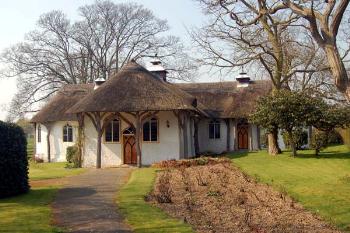Congregationalism in Roxton

Roxton Congregational Chapel March 2007
In 1808 the building and premises of Charles John Metcalfe of Roxton House [the Lord of the Manor] in occupation of William Brown, between the premises of Mary Garratt north and premises of Ann Rouston west with the close of C. J. Metcalfe south and the road east were registered by Metcalfe, William Brown and John Savile [ABN1/1 and ABN2/132]. H. G. Tibbutt wrote a pamphlet about the chapel in 1958 [CRT170] in which he quotes from the first entry in the Church Book: "On 31st May 1808, a barn belonging to C. J. Metcalfe was opened for occasional preaching on Lord's day and other evenings by ministers of different denominations, when Revd. W. Stevens, then of Prescott Street, London, preached in the morning from 2 Timothy 2:9 "But the word of God is not bound" and the Rev. S. Hillyard of Bedford in the evening from 1 Chronicles 29:5 "Who then is willing to consecrate his service this day to the Lord". Difficulties arising in obtaining supplies every Sabbath evening, Mr. Metcalfe conducted the services when no minister could be procured".
![Roxton Congregational Chapel about 1900 [Z1130/67]](/CommunityHistories/Roxton/RoxtonImages/z1130-67congregational chapel.JPG)
Roxton Congregational Chapel about 1900 [Z1130/67]
In 1822 a series of formal resolutions were adopted at the formation of Roxton chapel as an Independent Church. The barn was enlarged and altered around this time, developing into the thatch roofed and rustic looking meeting house of today. In 1825 a slim volume entitled Roxton Hymns was printed in London and sold for a shilling. An illustration of the chapel on the front shows that the two wings containing the rooms for the village day school and the Sunday School had not yet been added. Charles James Metcalfe died in 1855 and the church lost its sponsor.
The secular authorities wished to know how many people in the country attended worship and the rough proportions for each denomination. Thus a census of worshippers was held on Sunday 30th March 1851, known as the Ecclesiastical Census. It was not a particularly popular exercise and the day itself, cold, wet and unpleasant, did not exactly encourage people to go outdoors. Nevertheless, the deacon of the Roxton meeting, Thomas Newling of Colesden, reported that 105 adults and 70 Sunday scholars had attended in the morning, 75 Sunday scholars in the afternoon and 130 general congregation in the evening. The averages for the previous year had been 160 general congregation and 90 scholars in the morning.
It is of interest that Newling stated that the chapel was first opened in 1818 rather than 1808 as stated by Tibbutt, presumably this was a slip of the pen by the deacon. The chapel, at that date, had free seats for 188 and 104 reserved seats - a total of 292.The overall numbers of worshippers were about equal to those for the Anglican church in the village - this had had a total of 369 attendees at its two services, copmared with 380 at the three services at the Congregational chapel. The total population was 622.
In 1899 it was noted that mission services were undertaken at Chawston which were "much appreciated". During the First World War the congregation lost a number of its members - Peter Darrington, with 7th Battalion, Bedfordshire Regiment, on the first day of the battle of the Somme, Alfred John Covington and Wilfred Covington, both of 2nd Bedfords and both, also, on the Somme, Joseph Simcoe of 8th Bedfords , John William Gilbert of 1st Battalion, East Surrey Regiment, Alfred Darrington of 5th Gloucesters and Albert Walter Ekins of the Royal Flying Corps, whilst at home in one week in 1915 the church lost a congregation member, Mary Ann Barcock, a former pastor, Thomas Chapman and a deacon and Sunday School teacher George Caleb Covington.
![Private Covington's postcard back [X291/656/32]](/CommunityHistories/Roxton/RoxtonImages/X291-656-32 Private Covingtons postcard - back_351x285.jpg)
Private Covington's postcard back [X291/656/32]
Bedfordshire & Luton Archives & Records Service has a poignant postcard from Alfred Covington it shows the exterior of the chapel in the top half and a view of the interior of the chapel in the bottom half. It was posted in the field to his mother Mrs C Covington of 2 Council Cottages. The message includes the line: "sorry to send this but I have another like it this is one Mr Simcoe sent me a year ago. AC". The card is postmarked 31 Jul 1916, by which time its sender was already dead, killed in the 2nd Bedfords attack on Maltzhorn Farm near Guillemont, he was 24 [X291/656/32]. Private Covington has no known grave and is commemorated on the Thiepval Memorial.

Private Covington's postcard front [X291/656/32]
During the next world war the chapel had a narrow miss, again as reported by H.G.Tibbutt in the Church Book: "During the evening service on Sunday, December 17th [1944], we were somewhat alarmed when a flying bomb seemed to pass very low over the chapel and crashed in a field a short distance away. The only damage done to the chapel was a fused electric bulb and a few small panes loosened. the bomb cut the overhead cable and cast us into darkness, but our minister calmly went on with his sermon and then ended the service with the benediction". The County Control did not record this incident but did record one nearby a week earlier: Great Barford: V1 flying bomb also containing propaganda leaflets exploded at Northfield Farm, 150 yards west of Windmill Road; (10 Dec 1944) [WW2/AR/CO/2/3].
H.G.Tibbutt lists the pastors of the chapel from the first settled pastor until 1947:
1823-1831: Thomas Nottage;
1831-1851: Henry Winzar;
1851-1860: no settled pastor;
1860-1872: John William Rolls;
1873-1877: James Gunn;
1886-1908: Thomas Chapman;
1909-1913: James Hammil;
1914-1924: Richard Harmstone;
1925-1933: Ernest Slater;
1934-1935: Alfred Norman Rowland;
1935-1947: David Prothero
The Congregational chapel continues as a place of worship at the time of writing [March 2007].